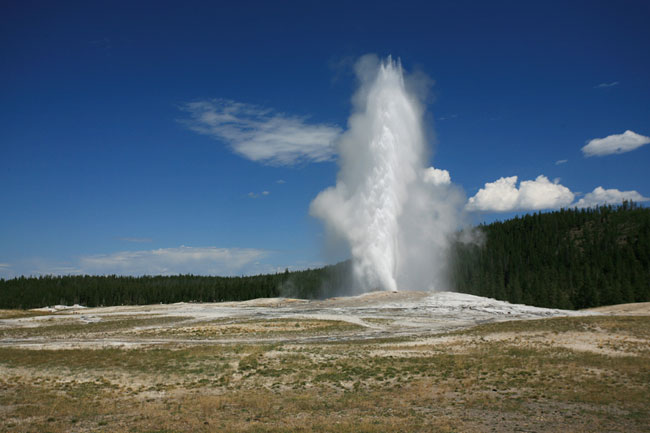Secret of Old Faithful Revealed

The faithfulness of Yellowstone National Park's iconic Old Faithful geyser depends in part on how much it rains in the area, a new study finds. For at least the past 135 years, Old Faithful has reliably spewed bursts of steam and hot water every 50 to 90 minutes (the frequency has recently hovered around every 91 minutes), to the wonder of tourists. More than 100,000 eruptions of the geyser have been recorded. Geysers are rare features on Earth; only about 1,000 of them exist and more than half of those are located in Yellowstone. For a geyser to form there must be a volcanic heat source, abundant ground water, and a geologic plumbing system (fractures, fissures and other open spaces in rock) through which the heated water can escape. The water escapes when the ground water is heated to boiling by the hot volcanic rocks. Expanding steam bubbles push the water overhead through the fissures in the rock until they overflow from the geyser. The escape of the top layers of water decreases the pressure on the hotter waters below, causing a chain reaction of violent steam explosions that expand the volume of the rising, boiling water by 1,500 times or more. This superheated water then bursts into the sky to form a geyser's familiar fountain. The new study, detailed in the June issue of the journal Geology, found that how often a geyser erupts depends partly on how much ground water is available to it, which in turn depends on precipitation levels. While most snow and rain that makes it to the ground runs off into rivers and streams, about 5 percent of it seeps into the ground. Scientists with the United States Geological Survey (USGS), Stanford University and National Park Service found that in years with higher precipitation levels in one part of Yellowstone, geysers there erupted more frequently. In years of extended drought, on the other hand, there should be longer intervals between eruptions. For small geysers, dry periods could shut off the geyser completely, said study author Shaul Hurwitz of the USGS. Precipitation isn't the only factor influence how often a geyser erupts though — earthquakes can also change the length of intervals between eruptions by re-arranging the underground plumbing of the geysers as the ground shifts. While the effect of precipitation on the frequency of eruptions is gradual, the effect of earthquakes is much more immediate. "It's a big instantaneous response," Hurwitz told LiveScience. The length of Old Faithful's eruption intervals have increased in recent years, both with decreased precipitation and earthquakes, Hurwitz said. Old Faithful can be seen erupting via a webcam on the National Park Service's Web site.
- Video: See Yellowstone National Park
- Volcanoes: Test Your Knowledge
- Images: Wild Volcanoes
Get the world’s most fascinating discoveries delivered straight to your inbox.

Andrea Thompson is an associate editor at Scientific American, where she covers sustainability, energy and the environment. Prior to that, she was a senior writer covering climate science at Climate Central and a reporter and editor at Live Science, where she primarily covered Earth science and the environment. She holds a graduate degree in science health and environmental reporting from New York University, as well as a bachelor of science and and masters of science in atmospheric chemistry from the Georgia Institute of Technology.


